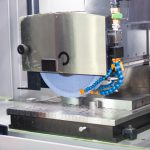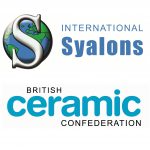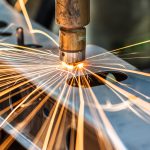Visit International Syalons and SILCA/Calsitherm at Hannover Messe 1–5 April 2019 at Stand L08, Hall 3, in the Ceramic Applications area.
Outlining Diamond Grinding of Ceramics
Advanced ceramics manufacturing comprises three essential stages: raw powder processing; forming; and sintering. This generally describes the process of consolidating a powder-based feedstock and firing the green body to achieve a fully-densified technical ceramic. Net shapes with comparatively loose dimensional tolerances (~1-3%) can typically be produced ‘as-sintered’; requiring no machining or finishing prior to quality assurance inspections. Components with tight tolerances cannot be produced ‘as-sintered’ and may require diamond grinding to ensure that the net shape is usable according to the design intent.
Continue readingBritish Ceramic Confederation Membership
International Syalons are delighted to announce their British Ceramic Confederation (BCC) membership.
The BCC are a professional organisation who represent the collective interest of all sectors of ceramic manufacturing in Britain by working extremely hard to safeguard the industry’s prosperity and lead sector discussions and negotiations with Government and public authorities.
Continue reading
Syalon 101 Extrusion Dies for Copper, Brass, and Nimonic Alloys
Extrusion describes the process where a metal such as copper or brass is forced through an extrusion die with a smaller cross-section. This deforms the material, causing a lengthening of its granular structure and forcing it to adopt a new cross-section uniformly across the entire manufactured workpiece. It is an extremely common metal forming process used to convert cylindrical billets into hollow tubes, or more complex profiles and sections.
Continue readingZircalon 30 – A New Grade of Fracture-Resistant Zirconia Ceramic for Welding Applications
International Syalons are pleased to announce the availability of Zircalon 30 a new grade of zirconia-based advanced ceramic with greatly improved fracture toughness, which is ideal for induction welding applications.
Continue readingCeramic Materials in Defence Applications
The 20th Century was an era of rapid innovation in ballistics technology, and subsequently in how conflicts were conducted. Military organisations worldwide opted to improve the manouverability of troops and vehicles without compromising the performance of protective equipment in response to high velocity impacts. This led to the gradual adoption of novel ceramic materials in defence applications.Continue reading
Benefits of Silicon Nitride Milling Media
Advanced ceramic grinding media are on the cutting-edge of wearing applications. The right grinding balls can be used to break down analytical samples, industrial intermediates, and more, simply by applying continuous abrasive forces. Generally, the goal is to reduce the size of particles, or to blend heterogeneous materials together. This can be carried out with hydraulic and pneumatic systems. But the oldest, simplest, and often most effective method, is to repeatedly impact sample materials with a tougher milling medium, causing particles to decompose through mechanical attrition.
Continue readingFestive Holidays Notice
International Syalons (Newcastle) Ltd. offices will be closed from Friday 21st December until Thursday 3rd January.
Molten Aluminium Degassing using Sialon
Molten aluminium (Al) is an extremely reactive substance. The molten metal is so reactive that it will readily decompose water in the atmosphere, or moisture on wet tools, releasing hydrogen into the melt. Even small volumes of water condensing on a crucible furnace or transfer ladle can affect the quality of final castings. Excess hydrogen can affect the distribution of porosity, and the total amount of shrinkage, ultimately increasing scrappage. Eliminating gas absorption from molten aluminium is unfeasible. So, metallurgists tend to focus on preventing hydrogen introduction into the melt and removing as much as possible prior to casting.
The Story of Ceramics in the UK
Ceramics are still widely associated with the elegant yet brittle shapes of traditional manufacturing, despite the astronomic strides that materials scientists and engineers have made over the last two and a half centuries. This is primarily due to the schism between commercial and technical ceramic materials. Retail ceramics retain a flair for aesthetics over functionality, which has roots in Romantic-era pottery and ancient porcelain. These products retain that traditional sense of style and continue to dominate the general public’s perception of what ceramics are capable of.Continue reading









